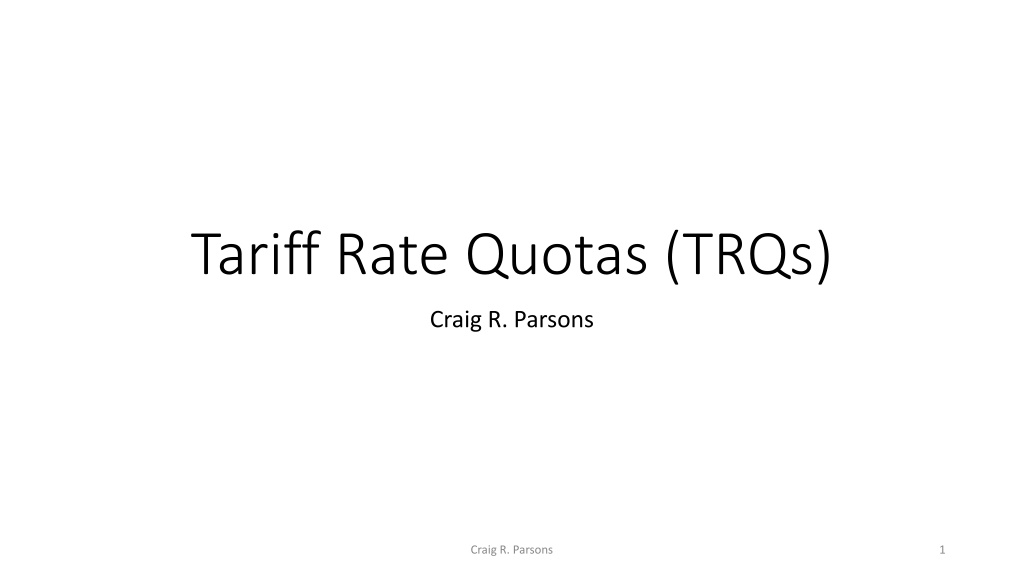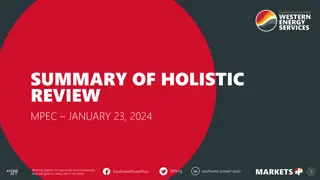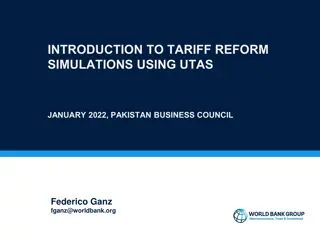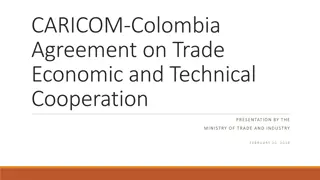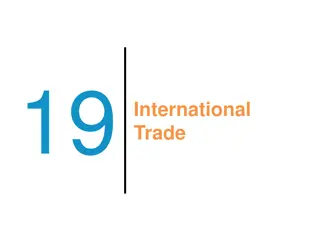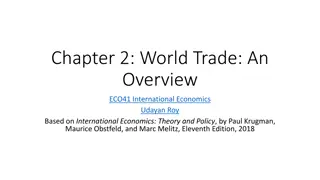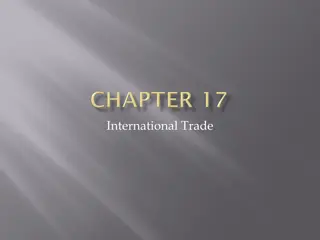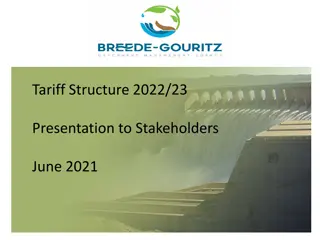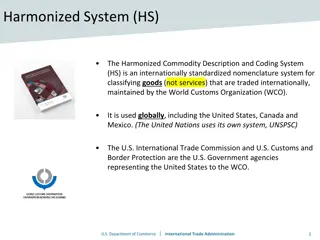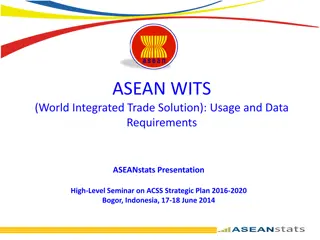Understanding Tariff Rate Quotas (TRQs) in International Trade
Tariff Rate Quotas (TRQs) are commonly used in global trade, particularly in agricultural imports. They involve lower tariff rates on imports up to a specified quantity per year, with higher rates applied to any excess imports. This system aims to regulate trade and protect domestic producers. TRQ licenses can be allocated through various methods, such as first come, first served or historical basis. Examples include Japan's TRQ on beef and the EU's TRQ on live sheep.
Download Presentation

Please find below an Image/Link to download the presentation.
The content on the website is provided AS IS for your information and personal use only. It may not be sold, licensed, or shared on other websites without obtaining consent from the author. Download presentation by click this link. If you encounter any issues during the download, it is possible that the publisher has removed the file from their server.
E N D
Presentation Transcript
Tariff Rate Quotas (TRQs) Craig R. Parsons Craig R. Parsons 1
TRQs Very commonly used in the US, Japan, the EU and virtually every country in the world, especially in agricultural imports. Rarely discussed in International Trade textbooks! Craig R. Parsons 2
How do TRQs work? The basic idea is that imports are subject a certain lower tariff rate on imports up to a certain quantity (per year). If imports exceed the import quantity for the year, a highest tariff rate is imposed on those `extra` imports. Example: Historically (since 1994) Japan has had a TRQ on importation of beef. While, the actual policy is a bit more complicated, the basic idea is: Tariff of 38.5% on imported beef up to the quota amount (about $1.6 billion per year from the US) Tariffs of 50% on imports of more than $1.6 billion. Craig R. Parsons 3
Stylized Example of a TRQ Suppose the fictional country of Economia has a TRQ in the importation of Pasta (presumably to protect its domestic pasta producers) The tariff is $1/ton (a specific tax) on all imports up to 20,000 tons per year The tariff is $2/ton on all imports over 20,000 tons per year So, suppose Economia imports 30,000 tons per year. The total tariffs levied would be: 20,000 x $1= $20,000 Plus $2 x 10,000 (30,000-20,000)= $20,000 So, the total tariffs collected would be $40,000 on the 30,000 tons of imported pasta. Craig R. Parsons 4
Examples of TRQ (or similar) Japan has a TRQ in beef. However, rather than fixing the quantity of the quotas for each year, the low rate (38.5% historically, pre- CP-TPP) is applied for all imports up to the quantity imported last year. If the imports this year are more than 17% higher than last year, then the higher rate 50% is applied on the `excess` imports. The US has TRQs in sugar. Also, very complicated, but basically a TRQ and are called `TRQ`s. The US also has a TRQ in imports of beef! But the US imports so little beef, that the quotas are not binding. The EU has a TRQ on the importation of live sheep. It is 10% (ad valorem) for importation up to the quota amount, and 835 euros (specific tariff) per tonne of sheep after that. Craig R. Parsons 5
How are TRQ licenses allocated? Like quotas, there are several ways the government can allocate the import quotas It can be `first come, first served`, or it can be on a historical basis (the major importers from last year, get the same share this year). Also, typically shares of the quotas are broken down across countries. To see how US allocated its quotas on sugar across countries, go here: https://www.federalregister.gov/documents/2018/07/18/2018- 15266/fiscal-year-2019-tariff-rate-quota-allocations-for-raw-cane- sugar-refined-and-specialty-sugar-and Craig R. Parsons 6
As you can see, TRQs are quite complicated The precise effects on producers, consumers and who gets the rent can be hard to work out. But the basic effects are the same as a tariff and quotas. Prices go up in importing country, which lowers Consumer Surplus ( Prices go up which benefits domestic producers of that good. Producer surplus increases. There is some tax revenue, but there can also be rents or even the foreign exporters, depending on how the TRQ is set up and administered. TRQs are most flexible than pure quotas, but less flexible than tariffs. to importers, Craig R. Parsons 7
Some other NTBs in importation of foods in Japan Beef is essentially restricted to imports from US, Canada, New Zealand and Australia due to concerns over food-and-mouth disease. (This is why you will often see imported Brazilian chicken, but not Brazilian beef.) Chicken also has a TRQ. This is also becoming more relaxed due to CP-TPP. Pork. Very unusual system. The so-called `gate` system in Japan. If the price of imported pork is below the gate price, the tariff is exactly set to offset it. Example. Suppose the `gate price` set the Japanese government is 100 yen/ 100 g. If the price of imported pork, is 90 yen, then the government sets the tariff at 10 yen (100-90=10). This is an example of what used to be called a `scientific tariff` As you can see, it is very destructive to trade. Under CP-TPP (and US-Japan agreement signed by Trump) the gate system with virtually disappear. In 9 (!) years, the tariff will only be a max of 5 yen per 100 g. Craig R. Parsons 8
More food import rules for Japan Potatoes. Very hard to import (illegal) due to concerns over importing the foreign potato blight (fungus) into Japan and destroying Japanese potato crops. Frozen french fry imports are okay, and also there are a few ports in Japan that can import potatoes, so long as they immediately are processed into potato chips, etc. Rice has a TRQ. Etc. etc. Craig R. Parsons 9
Addendum: (CP-TPP) CPTPP stands for Comprehensive and Progressive Agreement for Trans- Pacific Partnership. Originally the TPP was signed in 2016 by all 12 including, the US. Then, President Trump quit the TPP agreement. The remaining 11 countries, led by PM Abe, concluded a very similar agreement without the US and called is CP-TPP (signed in 2018). In 2019, US and Japan signed a bilateral agreement which follows many of the same terms as in the original TPP (especially on agriculture). The CP-TPP member countries are: Australia, Brunei, Canada, Chile, Japan, Malaysia, Mexico, New Zealand, Peru, Singapore, and Vietnam. Craig R. Parsons 10
